# Lecture 13 - Steering Behaviors ### SET09121 - Games Engineering <br /><br /> Leni Le Goff <br /> School of Computing. Edinburgh Napier University --- # Recommended Reading - Artificial Intelligence for Games. Second Edition. Millington and Funge (2009). - Whole chapter on steering behaviours. 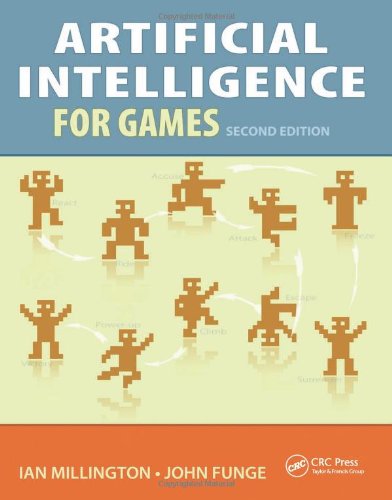<!-- .element width="30%" --> --- ## Review - Background Knowledge --- # Review - AI Techniques - There are numerous usable AI techniques applicable to games development. - Classical, deterministic techniques - popular. - Academic, non-deterministic techniques - useful in some areas. - Different techniques accomplish different aspects of game behaviour. - Movement. - Decision making. - Strategy. - Learning. - Today we will look at the basics of movement via steering behaviours. --- # Review - Working with Vectors - Steering behaviours rely on vector operations. - We are generally trying to work out positions and velocity to move entities in a certain manner. - We will be using vector operations to support our steering behaviours. - Adding and subtracting vectors. - Getting the length of a vector. - Normalizing a vector. - Converting vectors to angles. --- # Review - Basic Physics/Movement - Steering behaviours work with our physics engine. - Steering behaviours output a direction of travel. - And a rotation if you want to use it. - We use this output to influence our entities. - We can set the velocity directly. - We can apply the output as a force. - Remember: - Our physics engine is concerned with object movement. - Our steering behaviours are also concerned with object movement. - Therefore, combining the two is a good idea. --- ## Steering Behaviours --- # What are Steering Behaviours? - Steering behaviours are an AI technique that lets us program basic movement. - Movement is often considered the base ability of a game AI. - Steering behaviours are actually very simple. - They work on basic object positioning and rotation. - They provide an output which tells a game character which way to move. - This can be considered the velocity of an entity. - There are numerous examples (see the recommended reading): - Seek - Flee - Arrive - Avoid obstacle - etc. Useful resource: [Steering Behaviors For Autonomous Characters by C.W. Reynolds](https://www.red3d.com/cwr/steer/gdc99/) --- # Example - Flocking --- # Example - Flocking <iframe width="1400" height="800" src="https://www.youtube.com/embed/QbUPfMXXQIY" frameborder="0" allow="accelerometer; autoplay; encrypted-media; gyroscope; picture-in-picture" allowfullscreen=""></iframe> --- # Example - Game <iframe width="1400" height="800" src="https://www.youtube.com/embed/J2hI_eGGmzg" frameborder="0" allow="accelerometer; autoplay; encrypted-media; gyroscope; picture-in-picture" allowfullscreen=""></iframe> --- # Steering Behaviours - There are many steering behaviours out there. - Refer to the AI book for some of the most useful. - or to this online resource: [Steering Behaviors For Autonomous Characters by C.W. Reynolds](https://www.red3d.com/cwr/steer/gdc99/) - You can even define your own if you like. - We will only look at four: - **Seek** : move towards a target. - **Flee** : run away from a target. - **Arrive** : move towards a target and stop within a certain range. - **Face** : face the target. --- # Seek - Very simple idea. - Move towards a target. - Calculation: $$ d = target - position $$ $$v = \frac{d}{||{d}||} \times v_{max}$$ 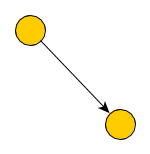 --- # Flee - Also simple - effectively the inverse of seek. - Run away from a target. - Calculation: $$d = position - target$$ $$v = \frac{d}{||{d}||} \times v_{max}$$ 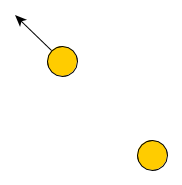 --- # Arrive - Seek, but with a stopping distance to stop the wiggle. - Move towards target and stop when within a given distance. - Calculation: $$d = target - position $$ $$ \left\lVert d \right\rVert \leq radius \implies v = 0 $$ $$ \left\lVert d \right\rVert > radius \implies v = \frac{d}{||{d}||} \times v_{max}$$ 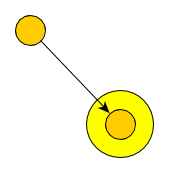 --- # Face - A rotational steer. - Turn to face a target. - Calculation: $$d = target - position $$ $$\theta = \arctan_2(d_y, d_x) $$ $$r = (\theta - orientation) * rot\_{speed}$$ 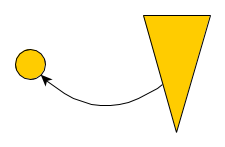 --- # Steering Behaviours in Our Engine - We want to build a reusable technique for steering behaviours. - We want reusable so we can program as many steering behaviours as we like. - If you like you can go further and combine steering behaviours within a single steering behaviour. - See weighted/combined behaviours in the recommended reading. - Read this article [Steering Behaviors For Autonomous Characters by C.W. Reynolds](https://www.red3d.com/cwr/steer/gdc99/) --- # Steering Output struct - `SteeringOutput` contains two values. - `direction`: the vector we want to travel in. - `rotation`: the angle we want to turn. - We will not use rotation in the practical, but it is there if you need it. ```cpp struct SteeringOutput { sf::Vector2f direction; float rotation; }; ``` --- # Steering Behaviour Implementation - There are different ways to implement steering behaviours. - OO approach: - Define a `SteeringBehaviour` abstract base class - With one pure virtual method: `get_steering` - `get_steering` performs the necessary calculation for the defined steering behaviour and outputs a `steering_output`. ```cpp class SteeringBehaviour{ public: virtual SteeringOutput get_steering() = 0; }; ``` Then, one class per type of steering behaviour. --- # Steering Behaviour Implementation The problem with the OO approach: - A lot of repeated code - Have to define a new class just to implement one function - Classes should be used when data needs to be carried with the procedure. 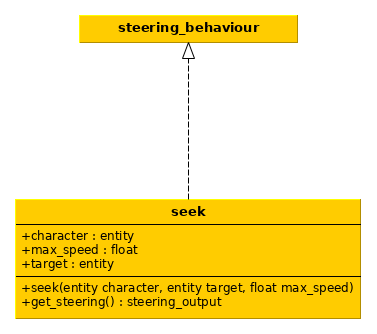 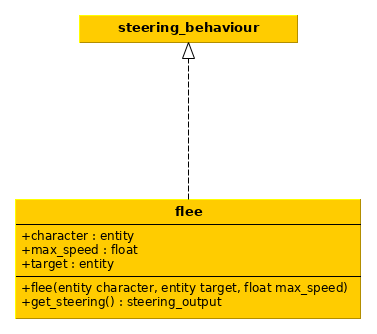 --- # Steering Behaviour Implementation Functional approach using std::function. - The only information needed for a steering behaviour is the target and agent positions. - So we can define a new type of function: ```cpp using SteeringFunction = std::function<SteeringOutput(const sf::Vector2f &,const sf::Vector2f &)>; ``` - Then define the steering behaviours as static variable: ```cpp struct SteeringBehaviours{ static SteeringFunction seek; static SteeringFunction flee; }; ``` Then, we just need to implement the functions. This is similar to the *strategy design pattern*. --- # Steering Behaviour Implementation Seek ```cpp SteeringFunction SteeringBehaviours::seek = [](const sf::Vector2f &target,const sf::Vector2f &self) -> SteeringOutput{ SteeringOutput steering; steering.direction = normalize(target - self); steering.rotation = 0.0f; return steering; }; ``` Flee ```cpp SteeringFunction SteeringBehaviours::seek = [](const sf::Vector2f &target,const sf::Vector2f &self) -> SteeringOutput{ SteeringOutput steering; steering.direction = normalize(self - target); steering.rotation = 0.0f; return steering; }; ``` --- # Steering Behaviour Implementation Then, we can use them in a steering component: ```cpp SteeringOutput output = SteeringBehaviours::seek(_player->get_position(),_parent->get_position()); move(output.direction*_max_speed * dt); ``` Where, - `_player` is a pointer to the player entity - `_parent` is a pointer to the parent entity of this component - `move` is a function to move the parent enity. --- # Combining Steering, Decisions, and State - Next we are going to discuss decision making and behaviour control using state machines and decision trees. - We will be looking at combining these ideas to create a sophisticated looking AI. - We will look at this in more detail next week. - The idea we will look at is when we make a decision (via a decision tree) we will change state. - For example, if we decide we are under attack we change our state to engage. - We can consider that the behavioural states also contain a steering behaviour if necessary. - For example having a seek state. --- # Example - The Sophisticated Guard - The guard has some basic actions: - The guard patrols between point A and point B. - The guard has a 20% chance of stopping while patrolling. - If the guard is shot at, the guard will stop patrolling, engage the player, and fire back. - If the guard sees the player, the guard will engage the player. - If engaged and the player is far away, the guard will seek the player. - If health is low, the guard will flee from the player. - If the guard loses sight of the player, the guard will return to patrolling between point A and point B. --- # Example - The Sophisticated Guard Diagram 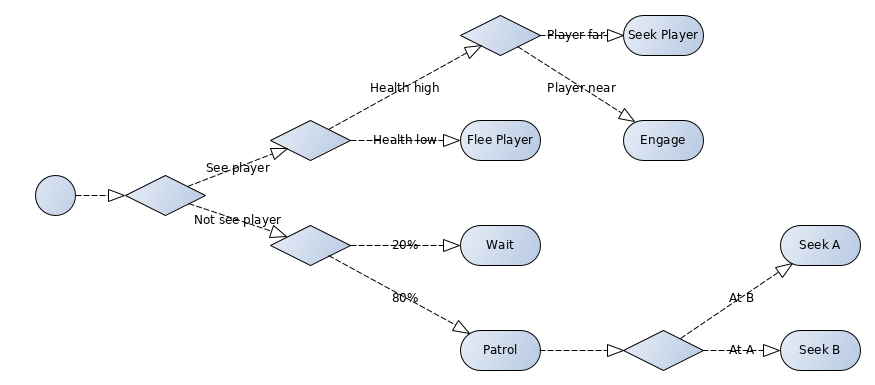 --- # Combining Steering Behaviours - We can also combine steering behaviours to create more elaborate movement. - This is how flocking works. - Remember that we can add vectors together quite happily. - This will give us a mean direction of travel. - We can combine steering behaviours normally. - For example combined seek and face. - Or we can weight the steering behaviours. - 0.8 seek. - 0.1 align. - 0.1 obstacle avoidance. --- # Comments on Steering - Steering behaviours are very simple. - They are also very fast to calculate. - They can also be very powerful. - Combining steering behaviours can lead to rich, complicated movement. - They also underpin the basis of many AI techniques. - Path finding uses a path following steering behaviour. - State machines and decision trees can determine which steering behaviour to perform. - Steering behaviours by themselves can lead to weird behaviour. - Remember some of the path finding examples. --- # Summary - As always, we have only really scratched the surface of steering behaviours. - There are numerous other behaviours out there. - Basic steering is good, but quite simple. - We normally want to combine behaviours. - Weighted. - Flocking. - Consider what behaviour you want, and just program the movement. - Do not worry about complexities.